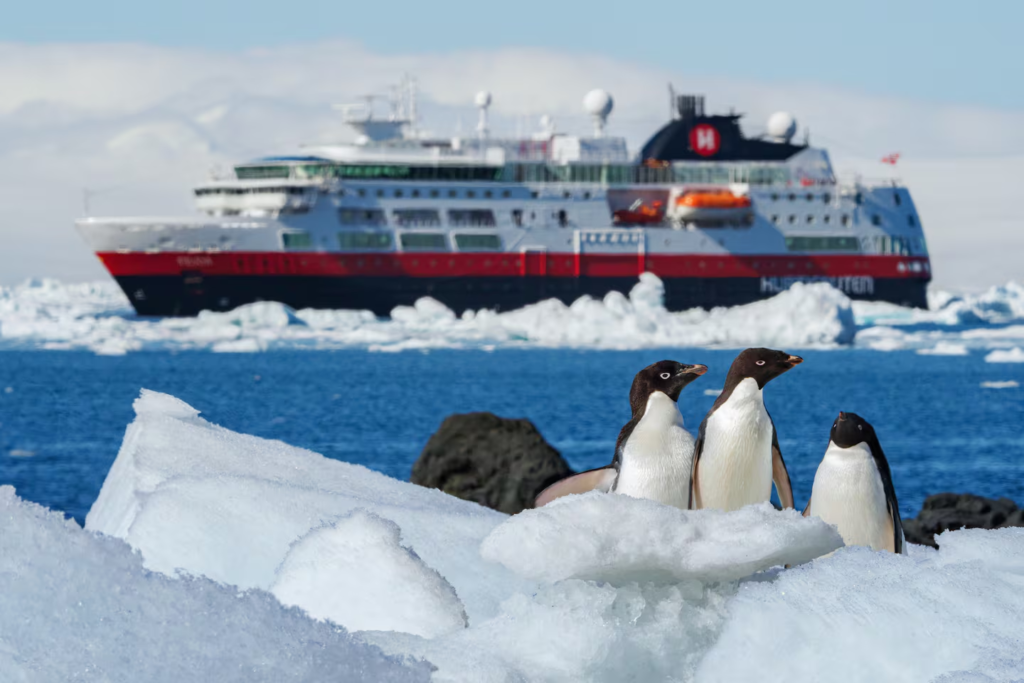Antarctica, the world’s last true wilderness, is experiencing an unprecedented surge in tourism. This remote, icy continent, long considered a sanctuary for scientific research and environmental preservation, is now facing an influx of over 100,000 tourists during the southern summer.
As cruise ships and adventurous travelers venture across the treacherous Drake Passage, the delicate ecosystem of this pristine landscape is under increasing strain.
The Rise of Antarctic Tourism
The history of tourism in Antarctica dates back to the 1950s when adventurous souls hitched rides on Chilean and Argentinian naval vessels resupplying research stations. Dedicated expedition-style icebreakers became the norm in the late 1960s, attracting more explorers to venture further south.
By the 1990s, a new wave of tourism began with the availability of ex-Soviet icebreakers, offering an unparalleled opportunity to experience the polar continent’s majesty.
By the turn of the millennium, annual tourist numbers had surpassed 10,000, and Antarctica was no longer the exclusive domain of scientists.
Fast forward to today, and the situation has escalated. Over 50 cruise ships now traverse the icy waters, and more than 100,000 visitors are expected this season, a staggering 40% increase from the pre-pandemic peak.
While the majority of tourists travel aboard expedition-style vessels, they follow a well-trodden path, usually to the accessible Antarctic Peninsula.
Read : Japan’s Iconic Mount Fuji Snowless in October for the First Time
Excursions involve brief landings where tourists observe penguin colonies, seals, and icebergs. For the more adventurous, activities like kayaking, paddleboarding, and even polar plunges are on offer. Some operators now provide overland journeys to the interior, catering to a growing demand for more extreme adventures.
Environmental Impact: A Delicate Balance Under Threat
Despite stringent regulations, the rapid increase in tourism poses significant environmental risks. Antarctica’s ecosystem is fragile, and even minor disturbances can have lasting effects. Black carbon emissions from cruise ship funnels are a pressing concern.
This soot settles on the snow, reducing its albedo (reflectivity), and accelerates melting. With climate change already affecting the continent, the additional strain from tourism exacerbates the problem.
Microbial contamination is another hidden threat. Tourists can inadvertently carry invasive species on their boots and clothing, introducing foreign microbes or seeds to the environment.

As ice melts and exposes more bare earth, these risks will only increase. Although measures like disinfecting boots and vacuuming clothing are in place, the sheer number of visitors heightens the risk.
The carbon footprint of Antarctic tourism is also alarmingly high. Due to the remote location, the per capita emissions for each tourist are significantly higher than those of other cruise destinations.
Even with newer, hybrid vessels that reduce emissions, the environmental cost remains substantial. Critics argue that sustainable cruises are an oxymoron, especially in such a sensitive region.
Sustainable Tourism or an Inevitable Decline?
The Antarctic Treaty System, a cornerstone of conservation efforts, imposes strict regulations on tourism. Operators must apply for permits and adhere to stringent environmental standards. Almost all cruise companies operating in the region are members of the International Association of Antarctica Tour Operators (IAATO), which enforces guidelines to minimize impact.
Yet, as visitor numbers grow, so do the challenges. Unlike other destinations, there is no resident population in Antarctica to voice concerns or protest against overtourism. The wildlife, the true residents of this icy expanse, are the most vulnerable. Increased human activity risks disturbing breeding patterns and altering natural behaviors.

Some advocates argue that Antarctic tourism plays a positive role by fostering a deeper appreciation for the environment. This concept, known as the “ambassador effect,” suggests that visitors return home with a heightened awareness of environmental issues. Travel writer Pico Iyer encapsulated this sentiment, describing his Antarctic experience as one that “awakens you to the environmental concerns of the world.”
However, the effectiveness of this ambassador effect remains debatable. Studies on whether polar travel translates to long-term pro-environmental behavior have shown mixed results. While some tourists may indeed become advocates for conservation, others may see their trip as merely a tick on their bucket list, with little lasting impact on their behavior.
Balancing Tourism and Conservation
The future of Antarctic tourism hinges on finding a delicate balance between access and preservation. Stronger regulations and better enforcement are necessary to mitigate the environmental impact. Initiatives such as mandatory reporting of fuel consumption and the adoption of hybrid technologies are steps in the right direction, but they may not be sufficient.
Some experts suggest imposing caps on the number of tourists or limiting the areas open to visitors. Others advocate for higher fees, with proceeds going toward conservation efforts. International cooperation is essential, as the Antarctic Treaty nations must collectively agree on measures to protect this fragile environment.

Tourists themselves have a role to play. Awareness and education are crucial. Travelers must understand that their visit carries an environmental cost and be willing to minimize their impact. Simple actions, such as respecting wildlife boundaries and adhering to biosecurity measures, can make a difference.
Antarctica stands at a crossroads. The surge in tourism brings both opportunities and challenges. On one hand, it offers a unique chance to foster global awareness about environmental issues. On the other, it risks turning this pristine wilderness into the next victim of overtourism.
The responsibility lies with all stakeholders—governments, tour operators, and tourists—to ensure that this remarkable continent remains untouched for future generations. Stronger regulations, sustainable practices, and a collective commitment to conservation are essential.
As travelers, we must recognize that our actions have consequences. Visiting Antarctica is a privilege, not a right. With careful planning and respect for the environment, we can help protect this last frontier. But without vigilance, we risk losing the very essence of what makes Antarctica so extraordinary.

